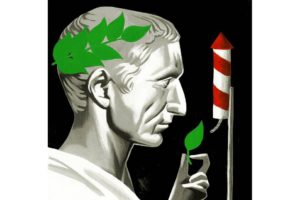WSJ Historically Speaking: The Long and Winding Road to New Year’s
The hour, date and kind of celebration have changed century to century
With its loud TV hosts, drunken parties and awful singing, New Year’s Eve might seem to have been around forever. Yet when it comes to the timing and treatment of the holiday, our version of New Year’s—the eve and day itself—is a relatively recent tradition.

ILLUSTRATION: THOMAS FUCHS
The Babylonians celebrated New Year’s in March, when the vernal equinox—a day of equal light and darkness—takes place. To them, New Year’s was a time of pious reckoning rather than raucous partying. The Egyptians got the big parties going: Their celebration fell in line with the annual flooding of the Nile River. It was a chance to get roaring drunk for a few weeks rather just for a few hours. The holiday’s timing, though, was the opposite of ours, in July.
New Year’s as we know it started to take shape with Julius Caesar’s redesign of the calendar in 46 B.C. He gave us Jan. 1, named after Janus, the Roman god of beginnings. Janus had another aspect appropriate to New Year’s: He is depicted as having a double-faced head—one looking back to the year ending, the other forward to the year to come. In his “Fasti,” which describes Roman holidays and customs and includes imagined conversations with various gods, the Roman poet Ovid complained to Janus that the new year should begin in spring, the time of flowering and the birth of crops. Janus answers, “Midwinter is the beginning of the new sun and the end of the old one.”
By the Middle Ages, the time around the vernal equinox had become popular again to start the new year. The Church preferred March 25, the date of the angel Gabriel’s annunciation to Mary of her pregnancy, to mark the New Year.
The old Dec. 31 New Year’s Eve celebrations didn’t return until the 16th century, following Pope Gregory XIII’s calendar reforms, which fixed a calendar error dating back to Julius Caesar’s time and, among the tweaks, restored Jan. 1 as the beginning of the year.
Even then, for the next few centuries knowing when New Year’s Eve began and ended was a tricky business, since different towns, not to mention different countries, had their own time zones. The U.S. alone had over 100 local zones.
Time only became standardized after 1884, when the more than two dozen countries attending the International Meridian Conference in Washington, D.C., agreed to adopt Greenwich, England, as the home of the prime meridian (where longitude is set as 0°).
Attempts to standardize time also contributed to that great American tradition, the ball drop at the stroke of midnight. ‘Time balls”—literally, large balls dropped from a great height—were originally used in seaports during the 19th century so that ship captains could set their chronometers. This was how New York Times newspaper owner Adolph Ochs had the idea in 1907 to drop a massive illuminated ball (with at least 100 lightbulbs) from a pole at the top of the Times building in what had recently been named Times Square.
We can blame the wonders of radio for the otherwise unaccountable popularity of “Auld Lang Syne.” The Scottish folk song was first transcribed by the poet Robert Burns in the 18th century, from an interview with an old man. In 1929, it was given a big-band makeover by Guy Lombardo and his Royal Canadian Orchestra during a live New Year’s Eve show broadcast from New York. Lombardo just happened to play the song around midnight, millions of radio listeners heard it, and a tradition was born.
Auld acquaintance—and perhaps how much Champagne was actually consumed—may be forgot, but New Year’s Eve never grows old.
